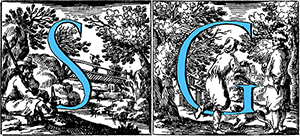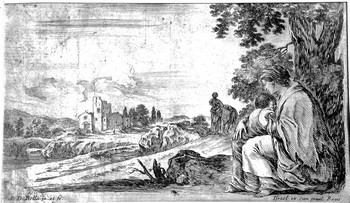
DELLA BELLA Stefano
(Florence 1610 – 1664)
Italian etcher, draftsman and painter born in a family of painters, sculptors and goldsmiths. He remained father orphan when he was still a child and initially dedicated himself to goldsmith art: first, in the workshop of the goldsmith Giovanni Battista Fossi, which he left little time later, and then he frequented the studio of the medalist Gasparo Mola (1580-1640). It seems that Della Bella began to copy the etchings of Jacques Callot (1592 – 1635) at the goldsmith’s workshop of Orazio Vanni.
Remigio Cantagallina (ca. 1582-1656), the master of Callot, helped the young Stefano at the beginning of his career and introduced him to the workshop of Cesare Dandini (1592 – 1658), where the artist studied painting since 1625. In his etchings he treated different subjects and various characters: soldiers, beggars, princes, satyrs, gardens, animals, ruins, festivals, theatrical scenes and scenes of everyday life. Initially, the influence and style of Callot’s prints are evident, but they tend to disappear in order to leave room for a more personal and pictorial vision.
Under the protection of Lorenzo de Medici, son of Grand Duke Ferdinando I, Della Bella had the opportunity to go to Rome for a study stay. During this period he produced many views of Rome, Tivoli, the Roman campaign as well as ruins and street scenes. Here he met French engravers and publishers such as Israel Henriet and François Langlois who, few years after Callot’s death, had great influence on his decision to go to Paris in 1639.
In 1637 he collaborated with Alfonso Paris (1606 – 56) as a scenographer at the Medici court. Following his good reputation as an engraver, he received numerous commissions from Richelieu and Cardinal Mazarino. Among these are the engagement of etching series of playing cards to teach mythology, geography, kings and queens of France to the young Dolphin (future Louis XIV).
In Paris he achieved a great artistic success, which allowed him to attend noblemen, artists and writers. A trip to the Netherlands in 1647 enabled him to admire the etchings of Rembrandt’s, and from that moment onwards you can see a reflection of the art of the Dutch master in the graphic production of Della Bella.
In 1649 he collaborated to the publication of “Les Triomphes de Louis le Juste XIII”, a work conceived by Jean Valdor (1616-1670) in honor of Louis XIII. In 1650, the Italian artist returned to his hometown and worked at the service of Mattia de ‘Medici as a drawing master of the young Cosimo III (1642 – 1723).
Meanwhile he has reached the pinnacle of his career with admission to the Florentine literary circle of the Academy of Apostles. In 1650 he was commissioned to work in Florence as a scenographer and costume designer in the organization of numerous court feasts.
As a drawing teacher of the young Cosimo III, he travelled with him to Rome to study antique works of art. After the definitive return to Florence he sent many engraved plates to the publishers of Paris who would do further reprint of his etchings. After a long illness, he died in Florence in 1664.












